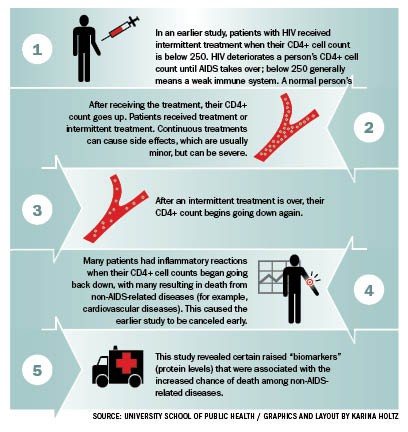A University of Minnesota professor was a major contributor in a HIV research breakthrough. The study, led by professor James Neaton and investigators at the International Network for Strategic Initiatives in Global HIV Trials, found a link between HIV treatment and a risk of death from non AIDS-related diseases. Released Monday, the study was called Strategies for Management of Anti-Retroviral Therapy (SMART), and it examined which form of HIV treatment would be more effective. It tested more than 5,000 people in 33 countries. People who received intermittent treatments for HIV, the study said, had double the risk of death as those who received continuous treatment. But those forms of death âÄî cardiovascular and liver disease âÄî are not commonly associated with AIDS. âÄúIt suggests that there may be a downside to HIV we did not anticipate,âÄù Neaton said. The study was cancelled early when there was an increased rate of death among patients who received intermittent treatment. When a person has HIV, the virus lowers their CD4+ cell count. If someone has a low CD4+ cell count, it means they have a weak immune system. In the SMART study, people with HIV received either continuous treatment or treatment only when their CD4+ cell count was below a certain level. Medical officer Karin Klingman helped oversee the study. She wanted to examine if intermittent treatments would work because continuous treatments are expensive and could result in severe side effects. âÄúTaking drugs continuously is a better option now than it was five years ago,âÄù she said. âÄúItâÄôs still an expensive proposition to treat.âÄù After the SMART study was cancelled, Neaton and other researchers discovered what caused the spike in deaths in the research. They found that certain protein levels correlated with cardiovascular and liver diseases elevate when intermittent treatment is finished. âÄúIt was a surprise when these went up,âÄù Klingman said. Neaton said even though the study was good, more research needs to be done. âÄúI think what it does is it opens up new avenues for research of what HIV does,âÄù Neaton said. Klingman and Neaton plan to begin a study to see if starting treatment sooner will be a better way to treat HIV patients. Klingman, however, is skeptical that the future study will go any more smoothly than the SMART study. âÄúI think most people, with the SMART study results, would be really hesitant to do any trials,âÄù she said. Both Klingman and Neaton want the study to go on, though, citing the need for more research. âÄúThe fact of the matter is, good data doesnâÄôt exist yet,âÄù Neaton said. According to the Centers for Disease Control, the number of people living with AIDS has gone up nearly 25 percent from 2002 to 2006. The number of deaths as a result of AIDS has decreased every year during that period.











